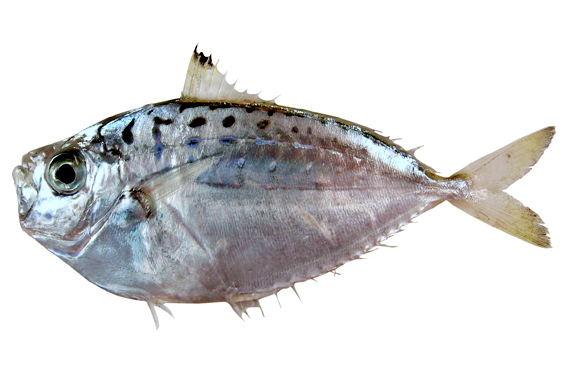Pugnose Ponyfish, Deveximentum insidiator (Bloch 1787)

Pugnose Ponyfish, Deveximentum insidiator. Source: Australian National Fish Collection, CSIRO. License: CC by Attribution-NonCommercial-ShareAlike
Summary:
A greenish to brownish ponyfish becoming silvery white on the sides (sometimes with minute dark spots), with 11–15 dark broken vertical bars and spots extending just below the lateral line, a black curved band from the lower margin of the eye to the rear angle of the lower jaw, a black tip on the anterior dorsal-fin spines, and a partly yellow caudal fin.
Cite this page as:
Bray, D.J. 2022, Deveximentum insidiator in Fishes of Australia, accessed 24 Apr 2024, https://fishesofaustralia.net.au/Home/species/2220
Pugnose Ponyfish, Deveximentum insidiator (Bloch 1787)
More Info
|
Distribution |
Exmouth Gulf, Western Australia, to Bundaberg, Queensland. Elsewhere the species is widespread in the Indo-west Pacific. Inhabits shallow coastal waters and estuaries, forming loose schools near the bottom. |
|
Features |
Dorsal fin VIII-IX, 15-16; Anal fin III, 14; Pectoral fin 17-18; Gill rakers (6-7)+(17-21); Lateral scales ~50. Body oval, compressed, depth1.6-2.5 in standard length. Head strongly concave above eye; mouth strongly oblique, pointing upward when closed, tip of maxilla reaching well below level of lower margin of eye; nuchal spine present; nostrils situated above eyes. Body scales small, 22–28 rows between bases of pectoral and pelvic fins; cheeks and breast, including isthmus, naked; lateral line barely visible, ending slightly before end of dorsal fin. |
|
Feeding |
Feeds on zooplankton including copepods, mysids, and larval fishes and crustaceans. |
|
Fisheries |
Taken mostly in bottom trawls. |
|
Etymology |
The specific name is from the Latin insidiator (= one who lies in ambush, a lurker, plotter) possibly in reference tot he highly protrusible mouth of this species. |
|
Species Citation |
Zeus insidiator Bloch 1787, Naturgeschichte der ausländischen Fische Vol. 3: 41, pl. 192(2, 3). Type locality: Surate [Surat], Surat District, India, Tapti River estuary, into Gulf of Khambhat, Arabian Sea. |
|
Author |
Bray, D.J. 2022 |
|
Resources |
Pugnose Ponyfish, Deveximentum insidiator (Bloch 1787)
References
Abraham, K.J., Joshi, K.K. & Murty, V.S.R. 2011. Taxonomy of the fishes of the family Leiognathidae (Pisces, Teleostei) from the west coast of India. Zootaxa 2886: 1-18
Blaber, S.J.M. 1980. Fish of the Trinity Inlet System of North Queensland with notes on the ecology of fish faunas of tropical Indo-Pacific estuaries. Australian Journal of Marine and Freshwater Research 31: 137-146. (as Secutor insidiator)
Blaber, S.J.M., Brewer, D.T. & Harris, A.N. 1994. Distribution, biomass and community structure of demersal fishes of the Gulf of Carpentaria, Australia. Australian Journal of Marine and Freshwater Research 45(3): 375-396. (as Secutor insidiator)
Bloch, M.E. 1787. Naturgeschichte der ausländischen Fische. Berlin : J. Morino Vol. 3 146 pp. pls 181-216.
Chakrabarty, P., Amarasinghe, T. & Sparks, J.S. 2009. Redescription of ponyfishes (Teleostei: Leiognathidae) of Sri Lanka and the status of Aurigequula Fowler 1918. Ceylon Journal of Science 37(2): 143-161
Chakrabarty, P., Sparks, J.S. & Ho., H.-C. 2010. Taxonomic review of the ponyfishes (Perciformes: Leiognathidae) of Taiwan. Marine Biodiversity 40: 107-121
Gloerfelt-Tarp, T. & Kailola, P.J. 1984. Trawled Fishes of Southern Indonesia and Northwest Australia. Jakarta : Dir. Gen. Fish. (Indonesia), German Tech. Coop., Aust. Dev. Ass. Bur. 406 pp. (as Secutor insidiator)
Hoese, D.F. & Bray, D.J. 2006. Leiognathidae. pp. 1176-1182 in Hoese, D.F., Bray, D.J., Paxton, J.R. & Allen, G.R. Fishes. In, Beesley, P.L. & Wells, A. (eds) Zoological Catalogue of Australia. Vol. 35. Volume 35 Australia : ABRS & CSIRO Publishing Parts 1-3, 2178 pp. (as Secutor insidiator)
Jones, G. 1985. Revision of the Australian species of the fish family Leiognathidae. Australian Journal of Marine and Freshwater Research 36: 559-613 figs 1-19 (as Secutor insidiator)
Kottelat, M. 2013. The fishes of the inland waters of southeast Asia: a catalogue and core bibliography of the fishes known to occur in freshwaters, mangroves and estuaries. Raffles Bulletin of Zoology Supplement 27: 1-663
Larson, H.K. & Williams, R.S. 1997. Darwin Harbour fishes: a survey and annotated checklist. pp. 339-380 in Hanley, H.R., Caswell, G., Megirian, D. & Larson, H.K. (eds). The Marine Flora and Fauna of Darwin Harbour, Northern Territory, Australia. Proceedings of the Sixth International Marine Biology Workshop. Darwin : Museum and Art Gallery of the Northern Territory 466 pp. (as Secutor insidiator)
Larson, H.K., Williams, R.S. & Hammer, M.P. 2013. An annotated checklist of the fishes of the Northern Territory, Australia. Zootaxa 3696(1): 1-293 (as Secutor insidiator)
Mochizuki, K. & Hayashi, M. 1989. Revision of the leiognathid fishes of the genus Secutor, with two new species. Science Reports of the Yokosuka City Museum 37: 83-95 figs 1-7 (as Secutor insidiator)
Randall, J.E., 2005. Reef and shore fishes of the South Pacific. New Caledonia to Tahiti and the Pitcairn Islands. Honolulu, Hawaii : University of Hawaii Press, 720 pp. (as Secutor insidiator)
Sainsbury, K.J., Kailola, P.J. & Leyland, G.G. 1984. Continental Shelf Fishes of Northern and North-Western Australia. Canberra : Fisheries Information Service 375 pp. figs & pls. (as Secutor insidiator)
Woodland, D.J., Premcharoen, S. & Cabanban, A.S. 2001. Leiognathidae. pp. 2792-2823 in Carpenter, K.E. & Niem, V.H. (eds). The Living Marine Resources of the Western Central Pacific. FAO Species Identification Guide for Fisheries Purposes. Rome : FAO Vol. 5 2791-3379 pp.(as Secutor insidiator)



